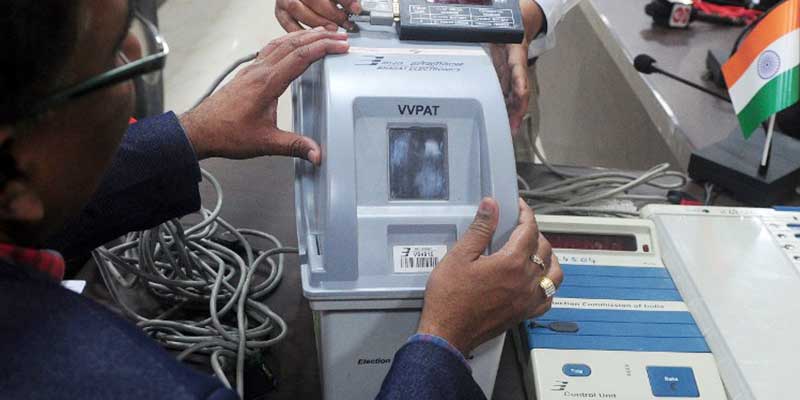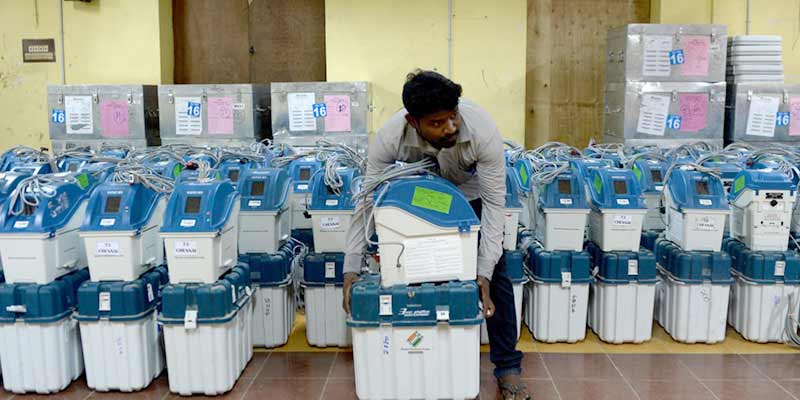- India
- Apr 27
Why SC rejected pleas for 100% verification of VVPAT slips?
• The Supreme Court has dismissed pleas for the 100 per cent verification of Voter Verifiable Paper Audit Trail (VVPAT) slips with the Electronic Voting Machine (EVM) count.
• While the SC bench acknowledged the fundamental right of voters to ensure their vote is accurately recorded and counted, it said the same cannot be equated with the right to 100 per cent counting of VVPAT slips, or a right to physical access to the VVPAT slips.
• The voter can see the VVPAT slip through the glass window and this assures the voter that his vote as cast has been recorded and will be counted.
• The SC bench noted that giving physical access to VVPAT slips to voters is problematic and impractical. It will lead to misuse, malpractices and disputes.
What is VVPAT?
• The government of India notified the amended Conduct of Elections Rules, 1961 on August 14, 2013, enabling the Commission to use VVPAT with EVMs.
• Voter Verifiable Paper Audit Trail (VVPAT) was first introduced on September 4, 2013 in the byelection for Noksen Assembly Constituency of Nagaland.
• VVPAT is an independent system attached with the EVMs that allows the voters to verify that their votes are cast as intended. When a vote is cast, a slip is printed on the VVPAT printer containing the serial number, name and symbol of the candidate and remains exposed through a transparent window for seven seconds. Thereafter, this printed slip automatically gets cut and falls in a sealed drop box of the VVPAT.
• The voter cannot take it home.
• The specially designed thermal paper used in the VVPAT is capable of retaining the printout for more than five years, so that the printout is available for manual verification by the court,if required in need of a dispute for cross checking the counting of votes cast.
• In April 2019, the Supreme Court directed the Election Commission to verify VVPAT paper slips from randomly selected five polling stations in every constituency.
‘Manual counting is prone to human errors’
• VVPAT slip is made of a 9.9cm x 5.6cm thermal paper coated with a chemical to ensure print retention for about five years.
• It is very soft and sticky, which makes the counting process tedious and slow.
• The counting process is undertaken through the following steps:
The verification of unique ID of the VVPAT, opening of the VVPAT drop box, taking out the paper slips, counting the total number of slips, matching the number of slips with the total votes polled as per Form 17C, segregation of candidate-wise VVPAT slips, making candidate-wise bundles of 25 slips and counting of bundles and leftover slips.
• There are instances of recounting and reverification of the slips till the candidate-wise tallying is done.
• Thus, the counting process takes about five hours.
• The counting is done by a team of three officers under CCTV coverage and under direct supervision of the supervising officer and the EC observer of the constituency. Candidates/agents are also present.
• The SC bench declined to modify its directions to increase the number of VVPAT undergoing slip count for several reasons.
• First, it will increase the time for counting and delay declaration of results.
• The manpower required would have to be doubled.
• Manual counting is prone to human errors and may lead to deliberate mischief.
• Manual intervention in counting can also create multiple charges of manipulation of results.
• Further, the data and the results do not indicate any need to increase the number of VVPAT units subjected to manual counting.
• The bench asked the Election Commission to look into the suggestions for the use of counting machines for VVPAT slips and the barcoding of the symbols loaded in the VVPATs.
• These are technical aspects, which will require evaluation and study.
• The Election Commission has been categoric that the glass window on the VVPAT has not undergone any change. The term used in Rule 49M is ‘transparent window’.
• The tinted glass used on the VVPAT printer is to maintain secrecy and prevent anyone else from viewing the VVPAT slips.
• The voter in the voting compartment who is viewing the glass from the top can have a clear view of the slip for seven seconds.
• Marginal tint on the VVPAT glass window, or the fact that the cutting and dropping of the slip from the roll into the drop box of the printer is not visible, does not violate Rule 49M.
• Section 49M deals with maintenance of secrecy of voting by electors within the polling station and voting procedures.
• Section 49MA deals with the procedure in case of complaint about particulars printed on paper slip.
• Use of glass window prevents damage, smudging, attempt to deface or physically access the VVPAT slip.
• The rule ensures that the voter is able to see the slip along with the serial number with name of the candidate and the symbol for whom they have voted.
Manorama Yearbook app is now available on Google Play Store and iOS App Store


